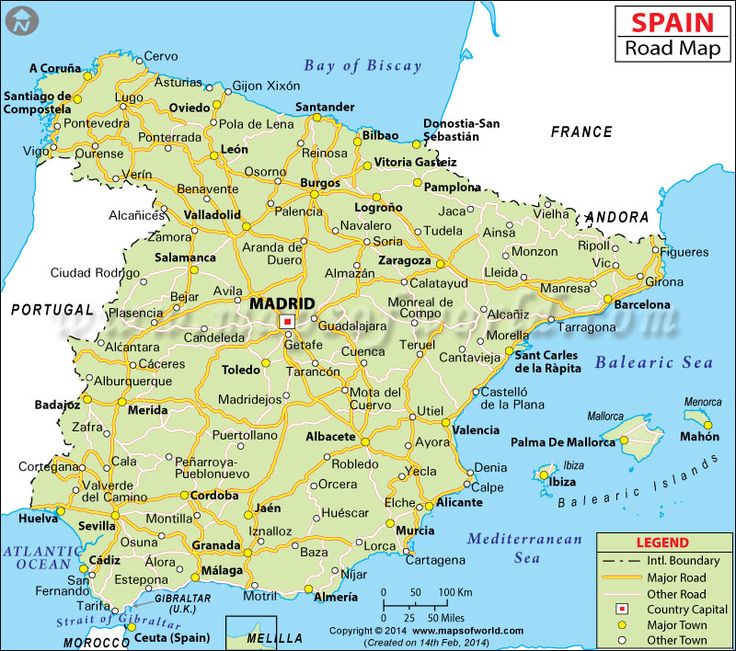Cities map of Spain – OrangeSmile.com
Spain hotels
The actual dimensions of the Spain map are 1413 X 1076 pixels, file size (in bytes) – 453829. You can open, print or download it by clicking on the map or via this link: Open the map of Spain.
The actual dimensions of the Spain map are 2000 X 1751 pixels, file size (in bytes) – 395071. You can open, print or download it by clicking on the map or via this link: Open the map of Spain.
Additional maps of Spain
General maps of Spain
Map of regions and provinces
Map of major sightseeings
Physical map of relief and rivers
Map of cities and regions in Spain
Nerja
Las Palmas
Cuenca Town
Galicia
Basque Country
Salamanca
Cadiz
Menorca
Oviedo
Murcia
Marbella
Gran Canaria
Fantastic City Tours and Excursions in Spain
Top sights in Spain
Ubrique
From the series “Monochromatic Cities – Stunning Views”
Ubrique is a town located in the province of Cádiz, Spain. This town attracts people with its picturesque snow-white houses. The town is situated in a breathtaking hill area, nevertheless it’s population goes up to 17 000 people. Over the ages, locals have been painting their houses in the garnishing white. This tradition wasn’t made only for beauty, white walls save people from the sweltering heat in the summertime.
Ubrique is an ideal place for long-lasting and leisure walks. It has a lot of beautiful streets that are decorated with fresh flowers and ornamental plants. The main historical symbol of Ubrique is the Convento dos Capuchos. Nowadays a part of the monastery is rebuilt in a museum. The greatest part of the exposition is devoted to the leather items and numerous …
Read all
Juzcar
From the series “Monochromatic Cities – Stunning Views”
A small Spanish town Juzcar is also known under the name “The Smurfs Village”.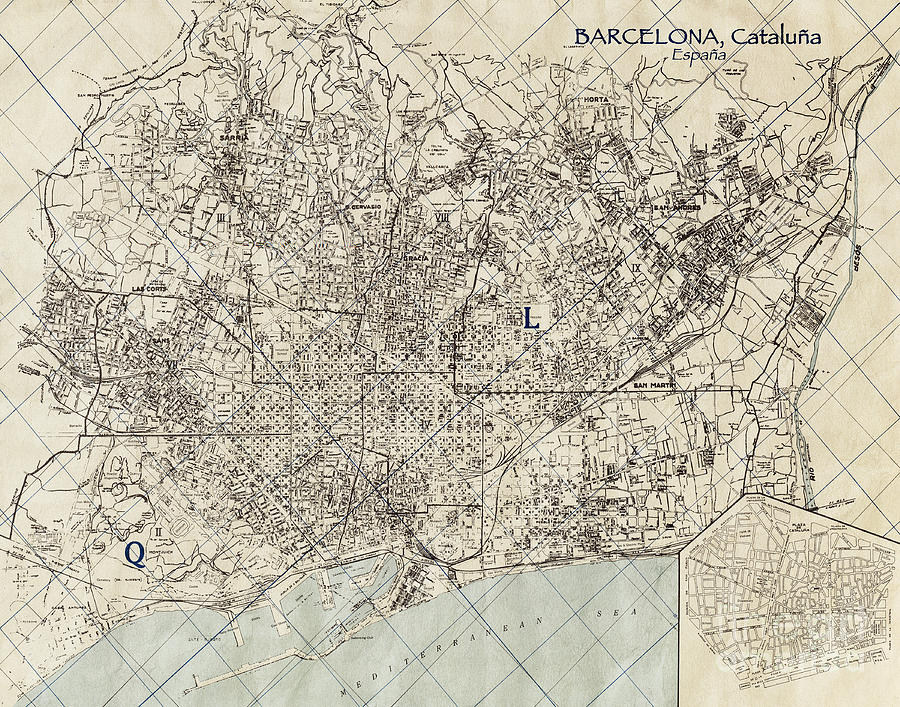
At present, you can find a lot of cafes and shops that are decorated in outstanding thematic style. Their walls are full of Smurfs graffiti. Also, there were made a lot of thematic sculptures. Well-known characters you can find everywhere. This town is very attractive …
Read all
All unique sightseeing Spain
Car rental on OrangeSmile.com
Expo 2020 in Dubai Was Visited by More Than 7 Million Visitors
If you haven’t visited this event yet, there is still time to book a hotel in Dubai because Expo 2020 Dubai runs until 31 March 2022.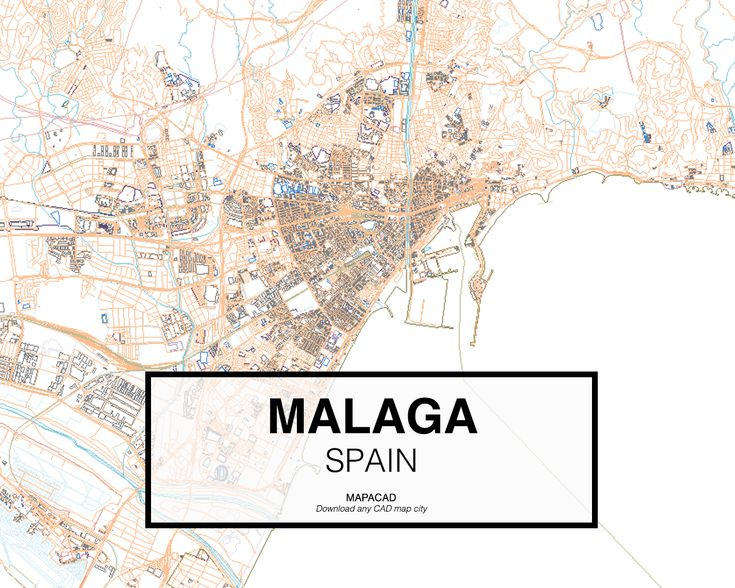
Read this
24.04.2023
Architecture of Spain in pictures
Culture of regions in Spain
Barcelona
As you know, Barcelona is one big attraction, and this is confirmed by the numerous interesting buildings that you meet at every step. Among them is Mabarcelone, one of the best works of Gaudi. There is also the Torre Bellesguard, built by this great architect. It is a bit different in style from his main works which makes it the more remarkable. There is also a reminder of the ancient Roman times in the capital of Catalonia. The Roman fort located in the Gothic Quarter serves as an evidence of … Read more
Madrid
For the fact that Madrid has a lot of attractions, the city is simply referred to as “the Museum under the open sky”.
Sevilla
Bypassing the Plaza de Espana would be simply cruel. This is one of the most recognizable symbols of the city. After the release of the film “Star Wars. Episode I: The Phantom Menace”, many people found out that one of the main sights of Seville is the city of Theda from the planet of Naboo. This is one of the most beautiful places in all of Spain, evoking mixed feelings of passion (and in Andalusia it cannot be otherwise), and romance. On the square you can meet flamenco dancers performing. … Read more
Benidorm
Benidorm has interesting museums – the Centro Cultural Maritimo for example, where visitors can get acquainted with the marine culture of south-eastern Spain and the traditional craft of the region; fishing to be precise.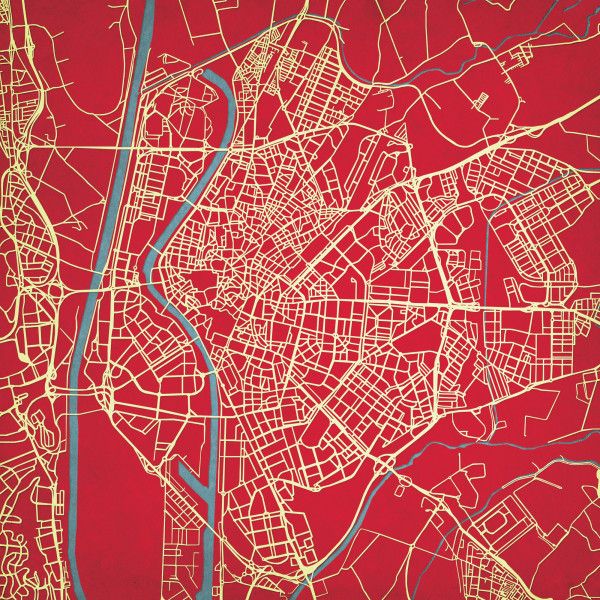
Granada
The old castle of Alcazaba is known as one of the main historical attractions of Granada. The castle is located just a short walk from Plaza de los Alhibes. The large-scale architectural complex was built back in the 13th century during the reign of Mohammed I. Unfortunately, only think fortification walls and several towers have survived from the original building. The height of one of the towers is 26 meters. Its top is equipped with a large observation deck, from which visitors can enjoy … Read more
Valencia
Many tourists begin their acquaintance with the city from the Plaza de Toros de Valencia – such arenas are in every major city of Spain, and, in fact, they demonstrate the “soul” of the city.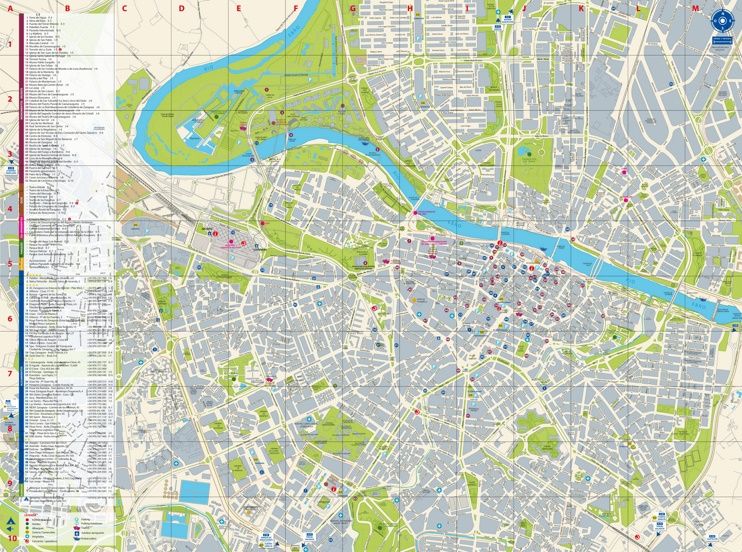
Salou
In the Middle Ages the city of Salou was an attractive strategic target of sea robbers and pirates. To protect the city and its residents from conquerors local folks erected a defense tower named Torre Vella. Thos fortifying construction has been well preserved till present days and is one of the most significant landmarks of the city. The ancient defense tower established in 1530 is now reequipped into a cultural center being an established place of holding of exciting exhibitions and other … Read more
Lloret de Mar
Cementiri Modernista is considered a peculiar local attraction for its beautiful sculptures, tombstones, and crypts- all of them can safely be called real works of art.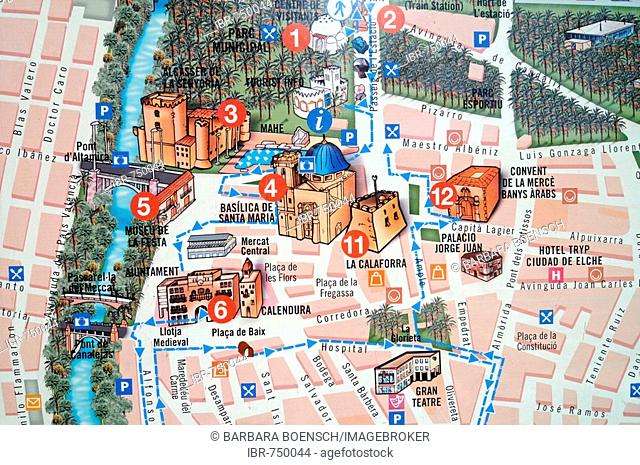
Cultural sights of Spain
OrangeSmile.com – online travel reservation expert providing reliable car rental and hotel booking services. We feature more than 25.000 destinations with 12.000 rental offices and 200.000 hotels worldwide.
Secure Server
Head office
Weegschaalstraat 3, Eindhoven
5632 CW, The Netherlands
+31 40 40 150 44
Terms of Service |
Privacy Policy |
About us
Copyright © 2002 –
OrangeSmile Tours B.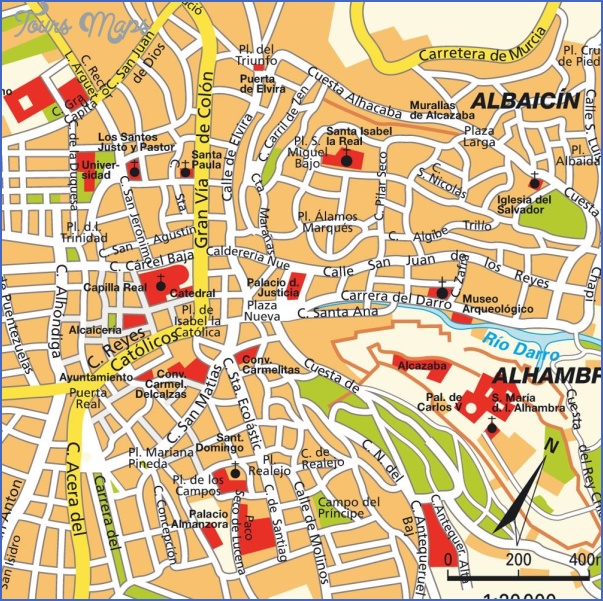
major cities and capital of Spain
You can find on this page the Spain cities map to print and to download in PDF. The Spain map city presents main cities, towns and presents the capital of Spain in Europe.
Map of Spain city
Print
Download
The map of Spain with cities shows all big and medium towns of Spain. This map of cities of Spain will allow you to easily find the city where you want to travel in Spain in Europe. The Spain cities map is downloadable in PDF, printable and free.
The old city of Salamanca is a World Heritage site, known as Spain ‘golden city’, it enclaves a rich historical, cultural and gastronomical culture. Some of the main attractions are Plaza Mayor, the Roman Bridge and the Cathedral which offers spectacular views of the city. Bilbao is one of the best cities to visit in northern Spain, famous for being the art hub in the country.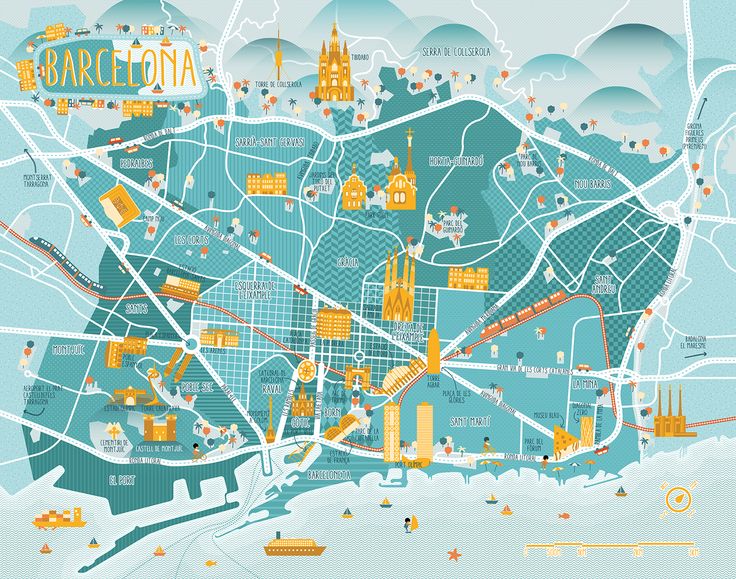
Granada is one of the best cities to visit in southern Spain, home to one of the great wonders of the world, the Alhambra Palace as you can see in the map of Spain with cities. This special city offers the ultimate cultural weekend break, nestled beneath the Sierra Nevada mountains and only an hour from the Costa Tropical, you can combine a stay in the city with a beach excursion or even a day trip to the ski resort. Málaga city has become one of the most popular cities for a city break in Spain in recent years. Modern, attractive, full of museums and terraces with spectacular views.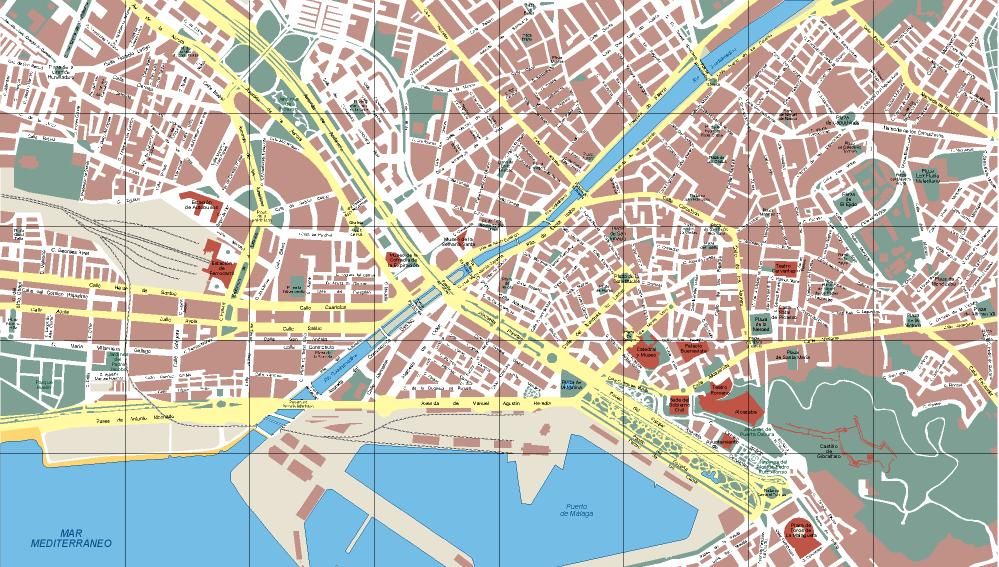
Ceuta and Melilla are called ciudades autónomas (autonomous cities) as its shown in the map of Spain with cities. Their status is in between regular cities and autonomous communities: on the one side, Ceuta and Melilla autonomous parliaments cannot enact “autonomous” laws, but, on the other side, they can enact regulations to execute laws, which are greater regulatory powers than those of regular city councils.
Map of Spain with main cities
Print
Download
The map of Spain with major cities shows all biggest and main towns of Spain. This map of major cities of Spain will allow you to easily find the big city where you want to travel in Spain in Europe. The Spain major cities map is downloadable in PDF, printable and free.
Madrid is the capital city of Spain and by far the country largest city.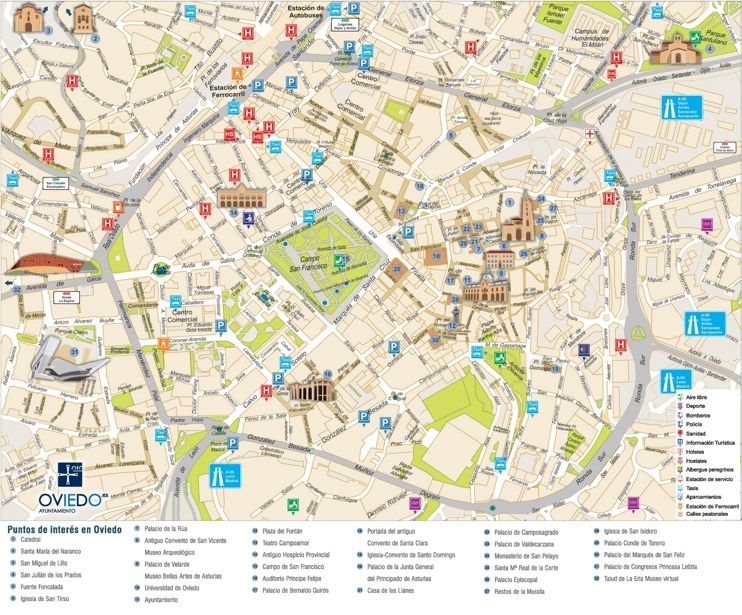
Madrid and Barcelona are the only two cities in Spain that have populations exceeding one million as you can see in the map of Spain with major cities. However, that does not mean that there are not other major cities in the country. There are 88 countries that have populations that fall between 100,000 and 1,000,000, and an impressive 707 cities with populations exceeding 10,000. These cities are spread among Spain 50 provinces.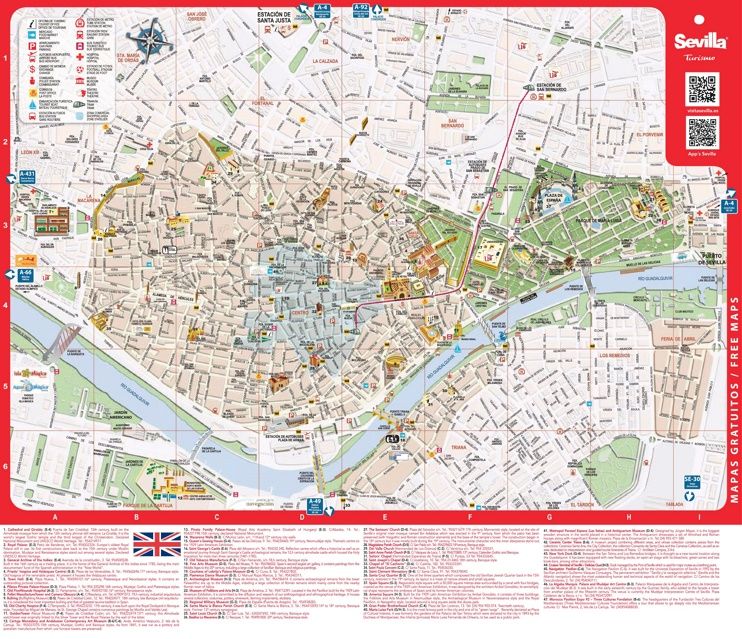
The total population of Spain is 46,733,038 as of 1-Jul-18 , which represents 0.61% of global population and ranks Spain # 30 worldwide. Spain has 2 major cities with more than a million people, 88 cities with between 100,000 and 1 million people, and 770 cities with between 10,000 and 100,000 people as its mentioned in the map of Spain with major cities. The largest city in Spain is Madrid, with a population of 3,255,944 people.
Map of Spain capital
Print
Download
The capital of Spain map shows the main city of Spain. This capital map of Spain will allow you to easily plan your travel in the capital of the country Spain in Europe. The capital of Spain map is downloadable in PDF, printable and free.
A city of many names, Toledo is known as the “former capital of the Spanish Empire”, the City of Three Cultures and the Imperial City as you can see in the capital of Spain map. It was once the home of the Royal Court, and the largest multicultural metropolis the Empire had ever seen.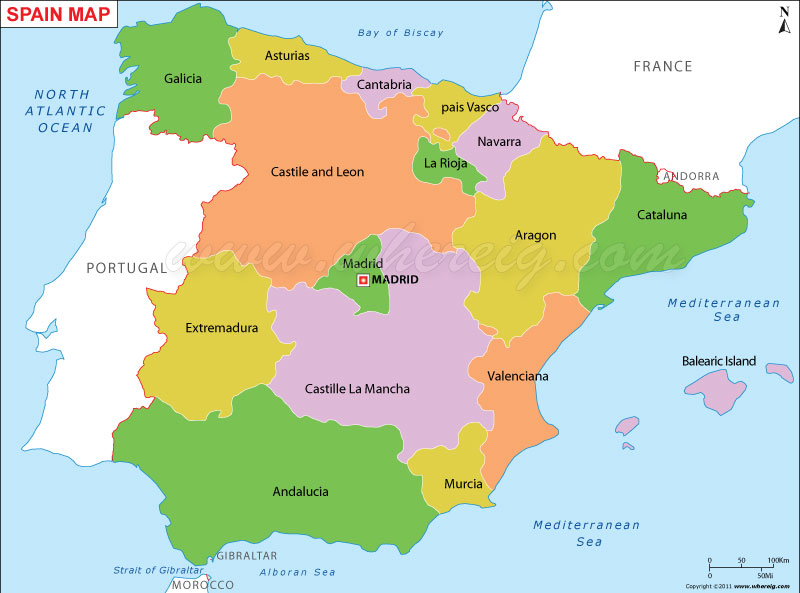
Madrid, formerly Magerit in Arabic and Matrit in Latin (often pronounced Madriz by locals). Formerly known colloquially as la Villa or the Town. Its coat of arms is a bear reaching to a strawberry tree and its flag a set of 7 white stars (four on top and three below) on a plain live red background. It has 6.5 million inhabitants the meteopolitan area, 4 million within the core of the city as its shown in the capital of Spain map. It is the residence of the prime minister, the king and all governement institutions.
Madrid, city, capital of Spain and of Madrid provincia (province). Madrid status as the national capital reflects the centralizing policy of the 16th-century Spanish king Philip II and his successors. The choice of Madrid, however, was also the result of the city previous obscurity and neutrality: it was chosen because it lacked ties with an established nonroyal power rather than because of any strategic, geographic, or economic considerations as its mentioned in the capital of Spain map.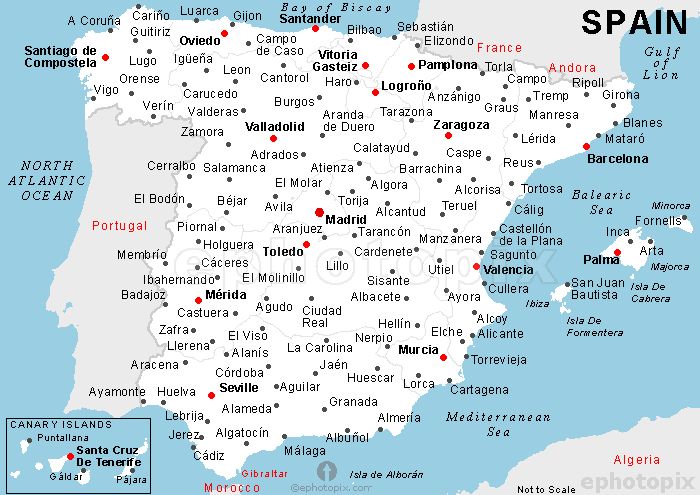
Map of Spain with cities in Russian detailed
Spain on the map – satellite and map
Move your mouse or screen to load the map
Geographical atlas
3
6
| No. | Locality | Federal subject | Stations ly | |
|---|---|---|---|---|
| 1 | Barcelona | Spain | 41.3870.2.1700 | 0 |
| 2 | 39.4641,-0.3757 | 0 | ||
| 3 | Madrid | Spain | 40.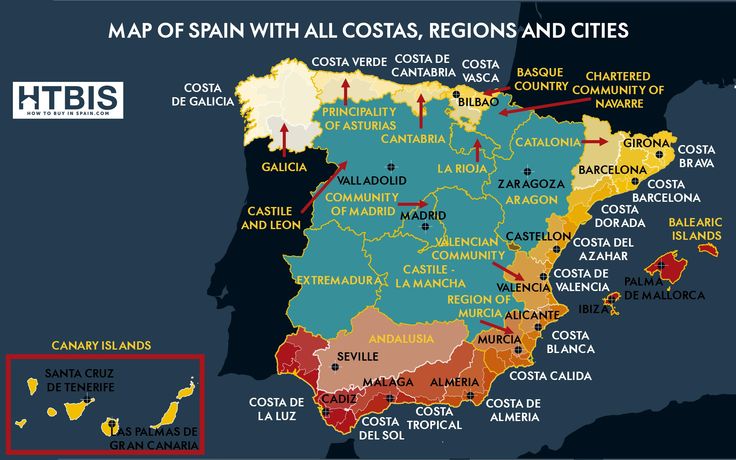 4193, -3.7009 4193, -3.7009 |
0 |
| 4 | Malaga | Spain |
Map of Spain. Geographical characteristic
Fanciful panoramas, favorable climate and abundance of sun are the hallmarks of Spain.
Spain is an independent European state that is a kingdom.
A detailed map of Spain shows that the country occupies 90% of the Iberian Peninsula plus two archipelagos – the Balearic Islands and the volcanic Canary Islands.
Spain is one of the ten largest countries in Europe and ranks fourth (its area is 505,990 km 2 ). On the mainland, Spain neighbors France, the dwarf principality of Andorra, as well as Portugal and the Gibraltar Peninsula. Also, the sovereign territories of the kingdom are located near the border of Morocco.
Spain on the world map: geography, nature and climate
Spain’s landscape is rather heterogeneous: mountain ranges and plateaus predominate (almost 90% of the area).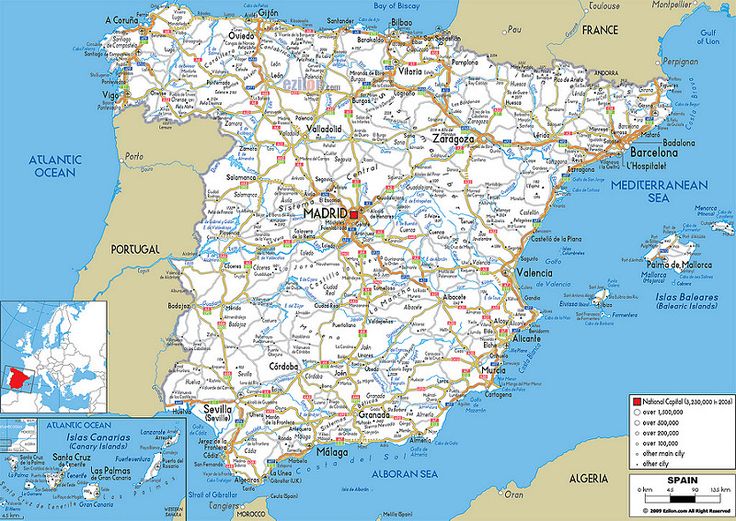
In the very center of Spain lies the Castilian Plateau, the highest on the European continent (approximately 660 meters). The plateau is completely surrounded by mountains. From the north and northwest side – Iberian, Cantabrian, Catalan and Pyrenees, from the south – Andalusian. These mountains are low, however, there are not many convenient passes.
The highest point in Spain is the dormant volcano Teide (3718 meters). A map of Spain in Russian shows that Teide is located on the island of Tenerife, the most populated in the Canary archipelago. It is followed by the southern glacier Mulasen (3478 meters) – the highest mountain of the Pyrenees.
Among the lowlands, the Andalusian (south of Spain) is the most extensive. The waterway of the province is the Guadalquivir River. In the valley of the Ebro River, the Aragonese Plain is located, which is a cross between a steppe and a desert. The largest rivers: Duero, Tagus, and Guadiana, characterized by changeable rapids.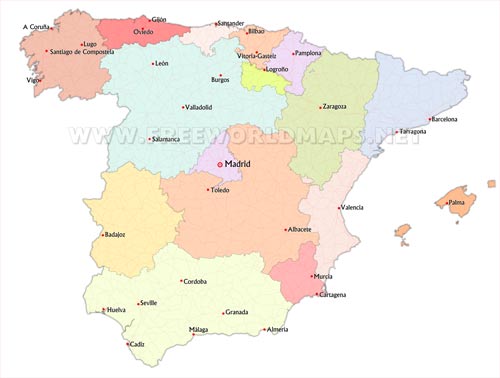
The climate is conventionally classified as Mediterranean. Additionally, steppe, continental and marine subtypes are distinguished in it. Spain is traditionally one of the warmest southern European countries. For 1 year, according to average estimates, there are from 260 to 285 sunny days. The average annual temperature is + 20˚C. In the winter months, negative temperatures are recorded in the center and in the north of the country. In summer, in the territories from the center to the southern coast, the thermometer reaches + 40˚C or more, and in the north it stays within + 25˚C. Most precipitation falls in the northwestern regions.
Spain stands out on the world map for its natural diversity. Here there are areas of semi-deserts, as well as evergreen oak groves. You can find many trees typical of Central Europe: beech, chestnut, birch and ash. In the south, classic Mediterranean shrubs (gariga and tomillars) grow.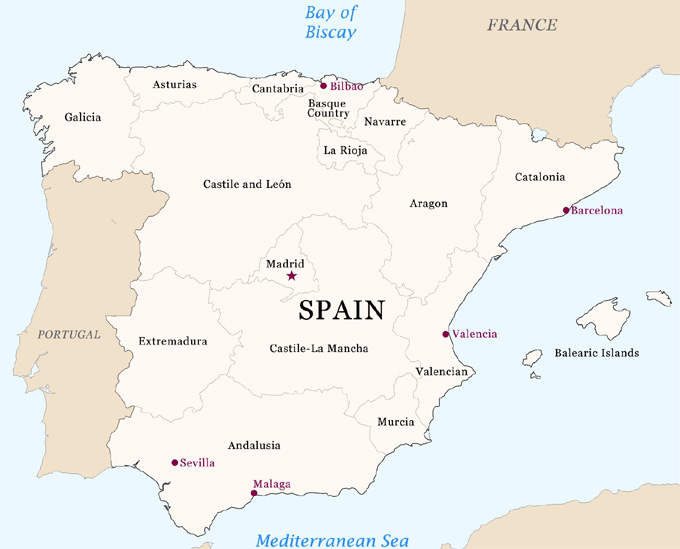
The animal world is also rich in various species. Predators include the Iberian lynx, foxes, wolves and brown bears. There are also deer, hares, moles. Of the birds, the blue magpie (only one of eight species of these birds lives in Europe) and the imperial eagle, whose population is declining, are found. Among the exotic animals, one can single out the Egyptian mongoose and the chameleon (only three large populations remain).
Map of Spain with cities. Administrative division of the country
Spain has 17 autonomous regions with 50 provinces. In addition, two autonomous cities are Spanish: Ceuta and Melilla, located on the African continent. The administrative structure of the country is guaranteed by the constitution and protected by the laws in force.
Largest cities in Spain:
- Madrid . The capital of the entire kingdom, located on the Manzanares River. This is the heart of the Iberian Peninsula. The population is about 3 million people.
The local climate has all the features of a continental one. Hot dry summers alternate with cold snowy winters. The metropolis is characterized by snowfalls. Temperatures can drop to record -20˚C.
- Barcelona . The main city of Catalonia. More than one and a half million people live here. This is a modern Mediterranean port, located 120 km from the French border. Winters are much warmer here than in Madrid, and summers are wetter.
- Valencia . It is located in the eastern part of Spain, where the Turia River flows into the Mediterranean Sea. It is the center of the province of the same name. It ranks third in terms of population. It has a subtropical climate. The air temperature during the winter months can reach + 17˚C.
For those who want to plunge into the unique flavor of the Iberian Peninsula, a map of Spain with cities in Russian will become an indispensable tool. It will help you to visit the most popular sights, walk through historical places, enjoy the originality of the old streets.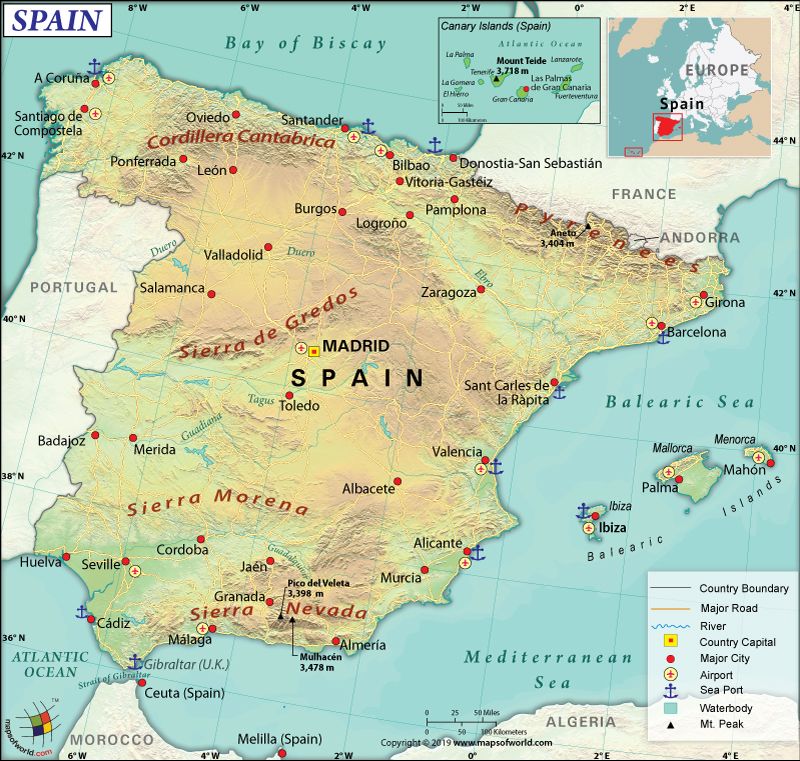
Search for areas, cities, stations on the site
Map of Spain with cities on a satellite map online
Spain or the Kingdom of Spain is a state located in southwestern Europe on the Iberian Peninsula. A map of Spain shows that the country is bordered by Portugal, the British territory of Gibraltar, France, Morocco and Andorra. The area of the country is 504,782 km2 (the 4th largest in Europe). The country is washed by the Atlantic Ocean and the Mediterranean Sea.
On a detailed map of Spain in Russian, you can see that the country is divided into 17 autonomous regions, which in turn are divided into 50 provinces. The country also includes 2 autonomous cities in Africa – Melilla and Ceuta. The largest cities of the country are Madrid (capital), Barcelona, Valencia, Seville, Malaga.
Today Spain is the country with the 9th economy in the world. The main economic sectors are: agriculture (winemaking, olive growing, olive oil), mining, shipbuilding, fishing and tourism.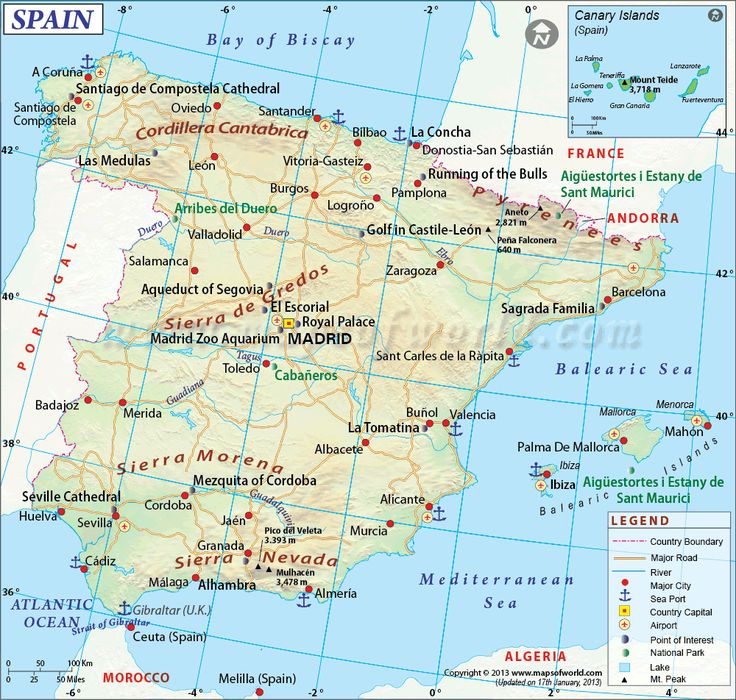
The mountainous terrain and favorable location create excellent conditions for tourism. On the territory of Spain are the mountains of the Pyrenees, where numerous ski resorts are located. On a satellite map of the coast of Spain, you can see that there are more than 2,000 beaches in the country.
Historical background
The territory of modern Spain was conquered by the Romans; then Christian states began to form. In the VIII century, almost the entire territory of the Iberian Peninsula was captured by the Arabs. The states of Leon, Aragon and Castile began a war for the return of lands from the Moors, which was called the Reconquista.
In 1515 a single monarchy is formed. In the XV-XVI centuries, the Spaniards discover new lands and send ships to the New World. In the XVII century, after the defeat in the war with England, the “Invincible Armada” loses its strength. In the 18th century, the War of the Spanish Succession begins. In the 19th century, 5 revolutions take place that lead to the creation of a constitutional monarchy.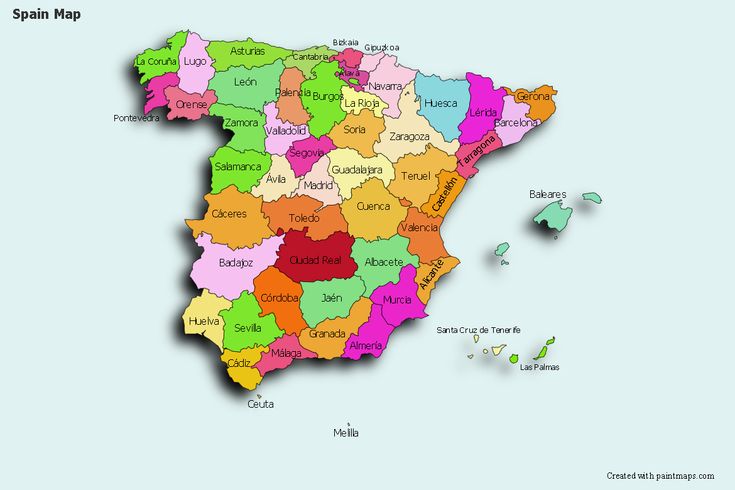
In 1939, the military dictatorship of F. Franco, who supported Nazi Germany, spread in Spain. In 1947, Spain became a kingdom again.
Regions of the country
Regional division of the country is as follows: 17 autonomous regions:
- Andalusia. It is located in the southwest of Europe, washed by the Strait of Gibraltar, the Mediterranean Sea and the Atlantic Ocean. Capital City Seville
- Aragon. Located in northern Spain, on the border with France. Adm. center – the city of Zaragoza
- Asturias. Located in northern Spain, on the coast of the Bay of Biscay. The capital is the city of Oviedo
- The Bolearic Islands are an archipelago located in the western Mediterranean Sea. Adm. center – the city of Palma
- Basque Country, part of the historical region (another part is in France). Located in the north of Spain, adm. center of Vitoria-Gasteiz
- Valencia. Located in the east of the country, on the Mediterranean coast, with the capital in the city of Valencia
- Galicia.
Located in the north-west of Spain, bordering the Atlantic Ocean and has its administrative center in the city of Santiago de Compostela
- Canary Islands. Archipelago of 7 islands off the northwest coast of Africa, has 2 capitals, Santa Cruz de Tenerife and Las Palmas de Gran Canaria (capitals change every 4 years)
- Cantabria, northern Spain. Has its capital city of Santander
- Castile-La Mancha, central region of Spain. The capital is the city of Toledo
- Castile-Leon, northwest Spain. The administrative center of the region is Valladolid
- Catalonia, the easternmost region of Spain, with its capital city of Barcelona
- Madrid, region in the center of Spain, with the administrative center in the city of Madrid (capital and largest city of the country)
- Murcia, a region in the southeast of Spain. The administrative center is located in the city of the same name Murcia
- Navarre, an autonomous region in the north of the country, on the border with France, with its capital in the city of Pamplona
- Rioja, northern Spain, the smallest region of the country with its capital in the city of Logroño
- Extremadura, southwest of the country, the capital of the region, the city of Merida
In turn, the autonomous regions are divided into 50 provinces; in which there is a further division into comarca (324 units) and, after that, into municipalities (more than 8000).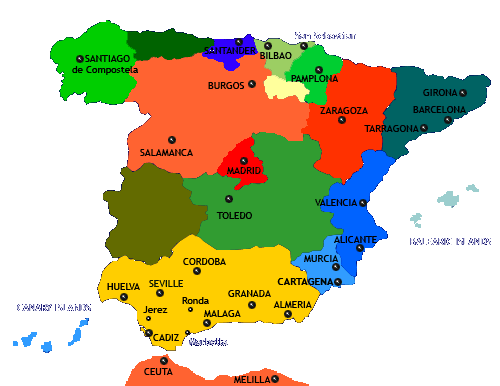
Sovereign territories of Spain. Territories located in North Africa with a population of about 170 thousand people. These are large territories, two autonomous cities:
- mountains. Ceuta, Spanish semi-enclave in northern Africa, bordering Morocco
- mountains Melilla, an autonomous port city on the African Mediterranean coast, bordering Morocco
And small areas:
- Alusemas group of islands, three islands located in the Mediterranean Sea (Penon de Alusemas, De Tierra, De Mar)
- Chafarinas group of islands, three islands in the Mediterranean off the coast of Morocco. They are a nature reserve; on the islands there is a Spanish garrison and a lighthouse.
- Perejil Island. A small uninhabited rocky island in the Strait of Gibraltar. It is located 5 kilometers from Ceuta.
- Alboran Island. Small island, nature reserve. In addition to the location of the Spanish garrison on it, it is uninhabited. There is also an automatic lighthouse on the island.
- Penon de Vélez de la Gomera, is located in the Mediterranean Sea. A small rocky uninhabited piece of land adjacent to the coast of Morocco.
The most interesting sights
Sagrada Familia
This Neo-Gothic church located in the city of Barcelona is one of the most famous sights of this city. The most famous long-term construction in the world – the construction of this attraction started in 1882 and continues to this day. The reason for this situation is that the construction is carried out exclusively on voluntary donations. In 2010, the building received the title Basilica Minor from Pope Benedict XVI. The temple is visited annually by more than 2 million tourists.
Alhambra
An architectural and park ensemble, a museum of Islamic architecture in the city of Granada, the pinnacle of Moorish art in Europe. In the Middle Ages, when the territory of present-day Spain was conquered by Muslims, this place served as the residence of the Muslim dynasty of Nasrid rulers (Nasrid dynasty, Spanish: Nazarí).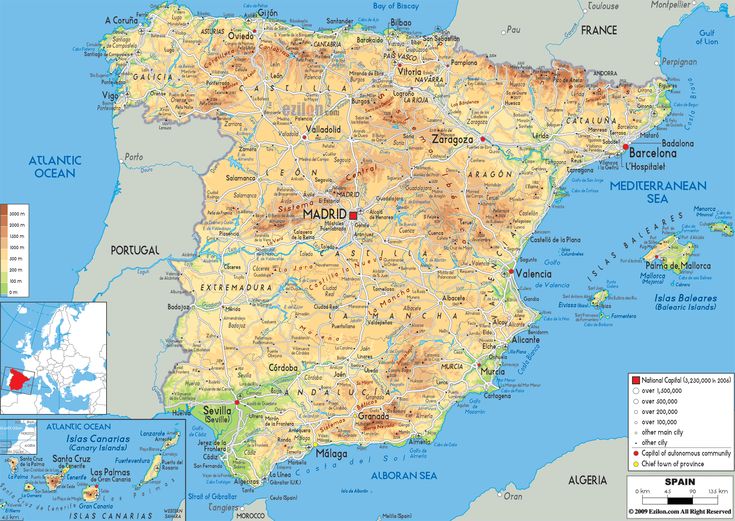
Guggenheim Museum Bilbao
One of the largest museums in Spain (11 thousand square meters of exhibition space), located on the banks of the Nervion River. It was opened in 1997 by the King of Spain Juan Carlos I, contains more than 200 works of contemporary art; the museum building itself is one of its main exhibits and is called a masterpiece of the 20th century.
White City of Andalusia
The towns and villages located in the Autonomous Region of Andalusia have recognizable typical architecture, red or brown tiled roofs and bright white walls, supposedly given this color by limestone. These settlements are characterized by narrow streets, steep ascents and descents, picturesque central areas with a square and a temple. There are routes to such cities and villages, for example Ronda’s White Towns route and Arcos de la Frontera’s White Towns route.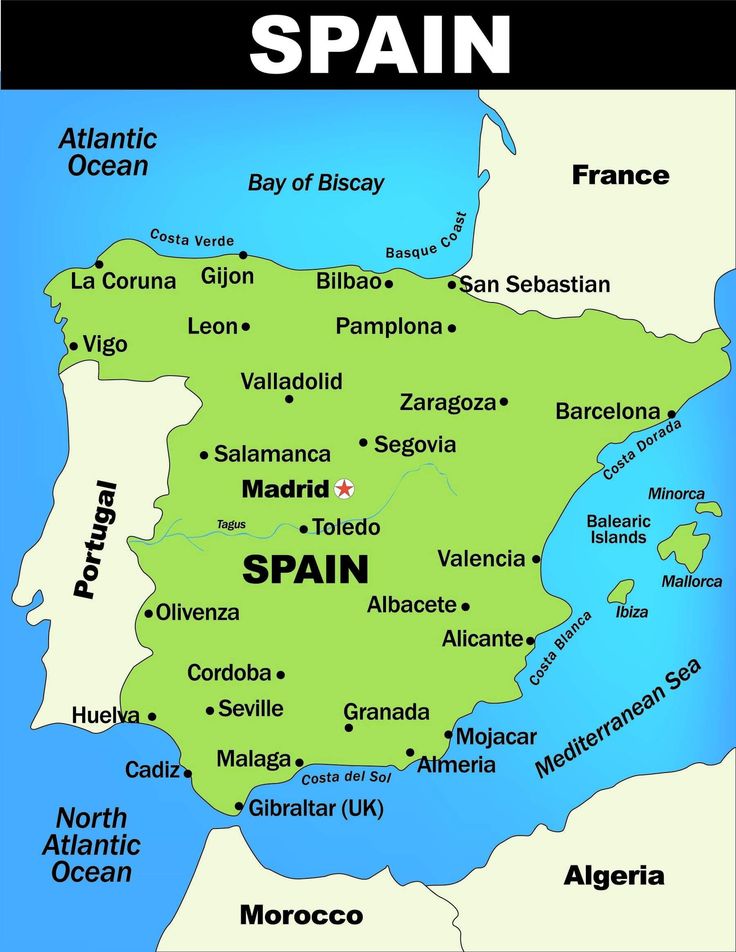
Mount Teide
Volcano located in the Canary Islands, the highest point in Spain; is active, the last eruption was recorded in 1909. Mount Teide has been given the title of Decade Volcano because of the devastation it can cause. It is part of the Teide National Park complex, is included in the UNESCO World Heritage List, and is the most visited natural wonder of Spain (about 4 million people a year).
Map of major airports
In most cases, air travel is the most convenient and fastest way to get to Spain. And, choosing this method of transportation, you need to understand which air harbor will be convenient to use for flights.
To do this, here is a list of the ten largest international airports in the country:
-
Adolfo Suárez Madrid-Barajas (Aeropuerto Adolfo Suárez Madrid-Barajas).
It is located in the capital of the country, the city of Madrid, and is the largest international airport in Spain, and the second in Europe. Passenger traffic is more than 61 million passengers. -
Josep Tarradellas Barcelona – El Prat Airport (Aeropuerto Josep Tarradellas Barcelona – El Prat).
Located 12 kilometers from Barcelona, the administrative center of the autonomous region of Catalonia. In terms of passenger traffic, it is in second place in Spain – it serves more than 52 million passengers a year. -
Palma de Mallorca (Aeropuerto de Palma de Mallorca).
Located a few kilometers from the city of Palma (Bolearic Islands), and serves about 29million passengers a year, being the third airport in Spain in terms of passenger traffic. -
Malaga – Costa del Sol (Aeropuerto de Málaga-Costa del Sol). 19.8 million people per year and fourth in Spain. The main airport serving the world famous tourist beach center of the Costa del Sol.
-
Alicante-Elche Airport (Aeropuerto de Alicante-Elche). Located 9 kilometers from the city of Alicante; transports about 15 million passengers per year, which puts it in fifth place in Spain.
-
Gran Canaria Airport (Aeropuerto de Gran Canaria). 13 million passengers per year; main airport for the Canary Islands.
-
Tenerife South Airport (Aeropuerto de Tenerife Sur).
It is the second busiest airport in the Canary Islands, and the 7th largest international airport in Spain with a passenger flow of 11 million passengers per year. -
Valencia Airport (Aeropuerto de Valencia).
Located 7 kilometers from the city of Valencia; and has an annual passenger traffic of 8.5 million people. -
Ibiza Airport
Serves the famous resort island, operates domestic and international flights with an annual passenger flow of 8.1 million people. -
Seville Airport (Aeropuerto de Sevilla).
Main airport for Western Andalusia and surrounding provinces. Annual passenger traffic of 7.5 million passengers.
Motorways of Spain
Motorways of Spain are divided according to the regional division of the country: there are state roads (about 26 thousand kilometers), roads of autonomous regions (about 71 thousand kilometers), provinces (68 thousand km) and municipalities (480 thousand km) . Also, in Spain there is a network of motorways, the length of which is about 17 thousand km. The road networks of Spain are integrated into the European road networks and the roads of the European Union, in addition to their own Spanish number, have a duplicate European standardized number.
Must Visit
Spain is one of the most popular tourist countries in Europe, a kind of open-air museum. It is recommended to visit Barcelona, Madrid, Seville and Valencia, the seaside resorts of the Costa Brava, Costa Blanca and Costa Dorada, the ski resorts of the Sierra Nevada, Valdescarai, Astun and Alto Campo.

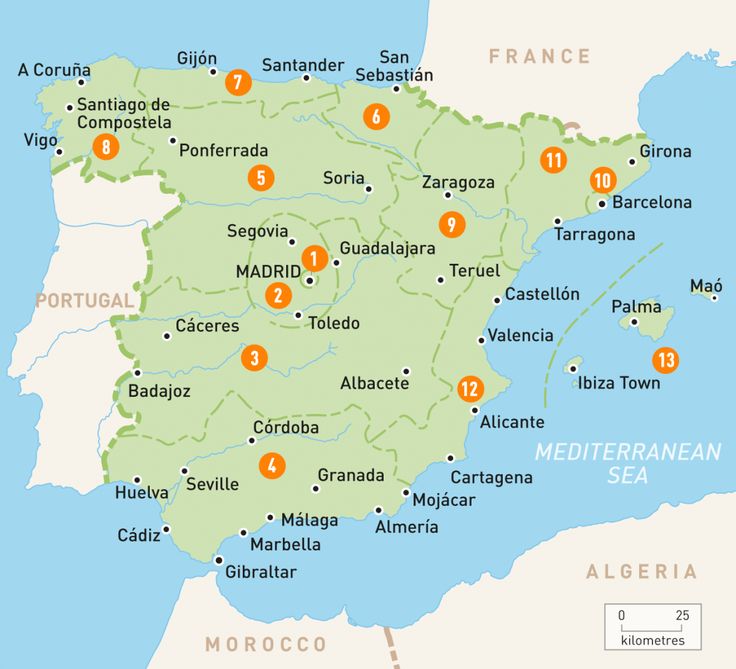 The local climate has all the features of a continental one. Hot dry summers alternate with cold snowy winters. The metropolis is characterized by snowfalls. Temperatures can drop to record -20˚C.
The local climate has all the features of a continental one. Hot dry summers alternate with cold snowy winters. The metropolis is characterized by snowfalls. Temperatures can drop to record -20˚C. 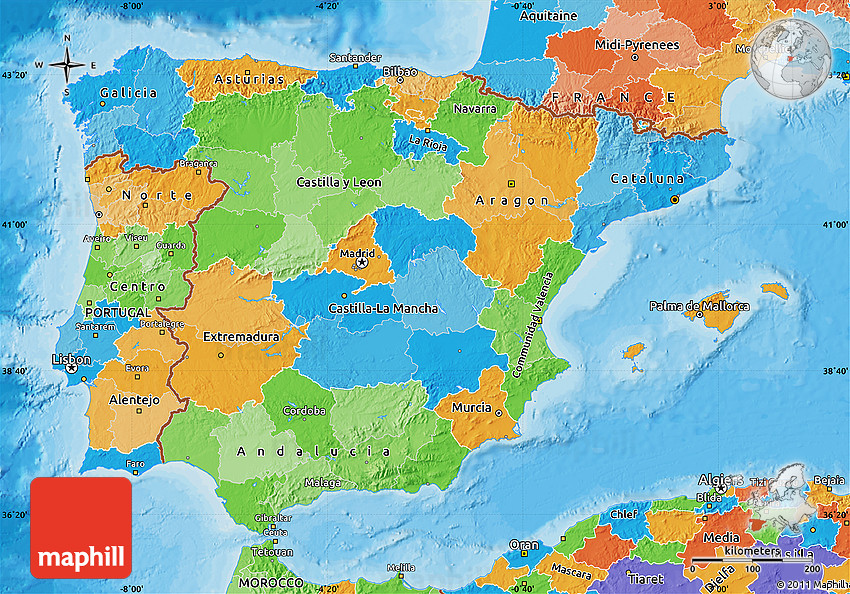 Located in the north-west of Spain, bordering the Atlantic Ocean and has its administrative center in the city of Santiago de Compostela
Located in the north-west of Spain, bordering the Atlantic Ocean and has its administrative center in the city of Santiago de Compostela 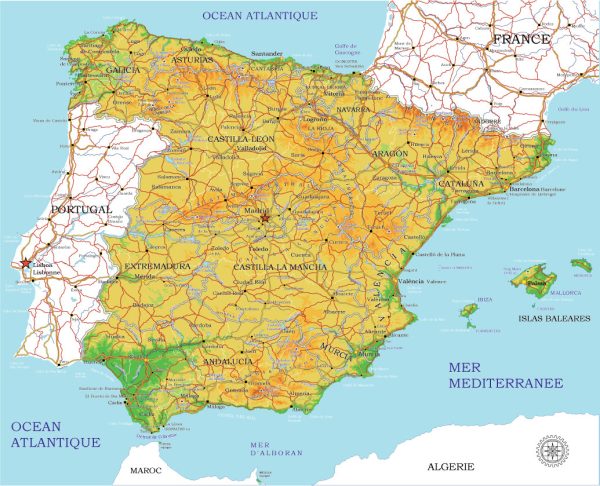

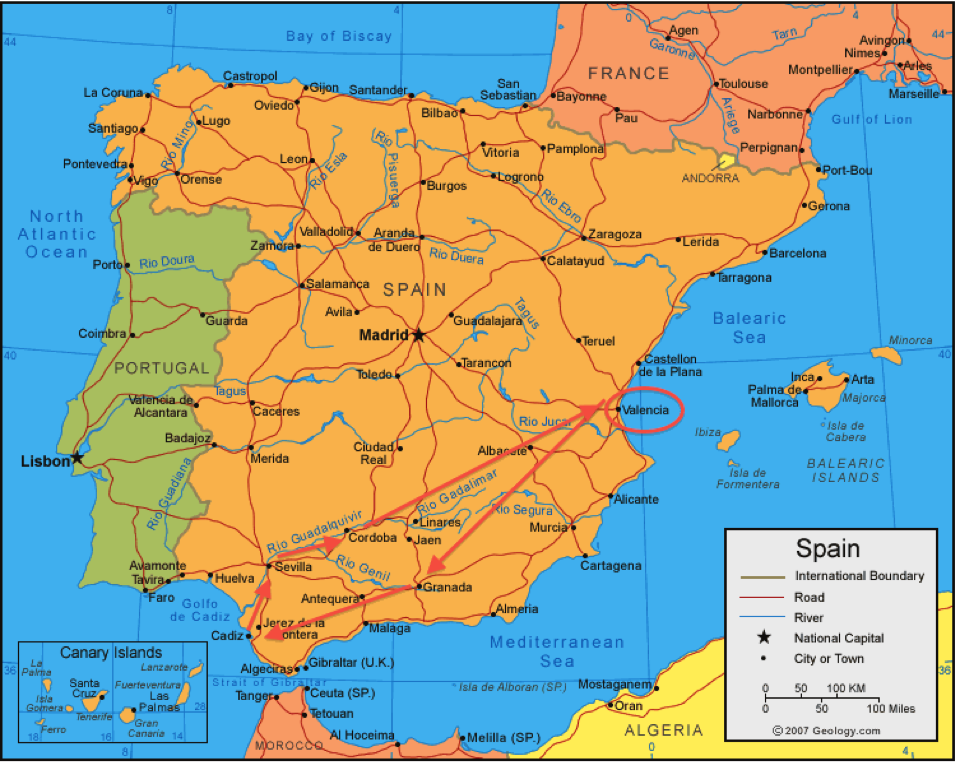
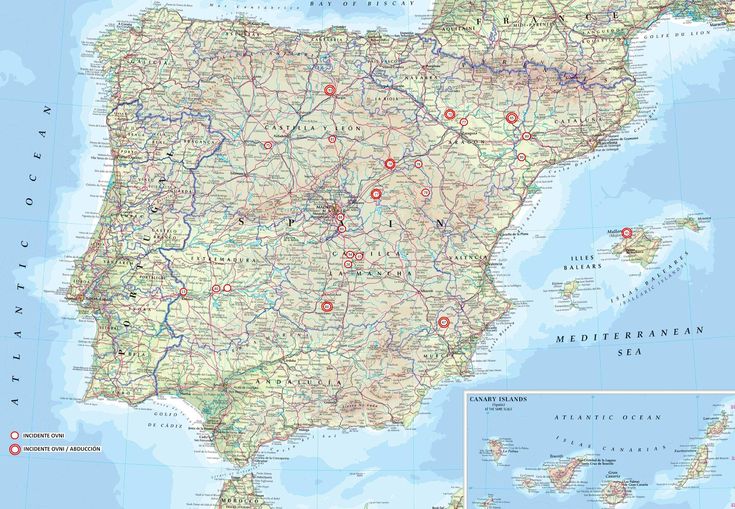 Main airport for Western Andalusia and surrounding provinces. Annual passenger traffic of 7.5 million passengers.
Main airport for Western Andalusia and surrounding provinces. Annual passenger traffic of 7.5 million passengers. 